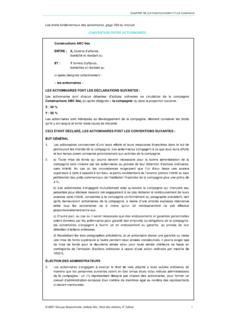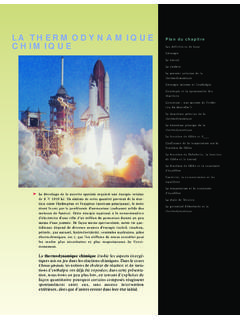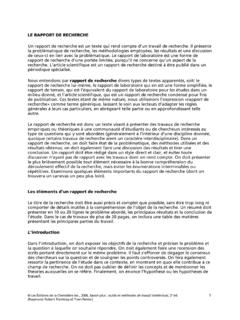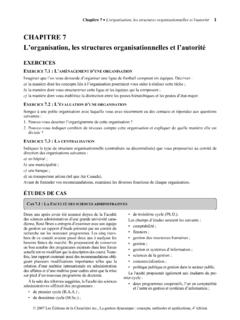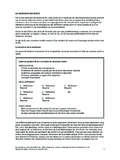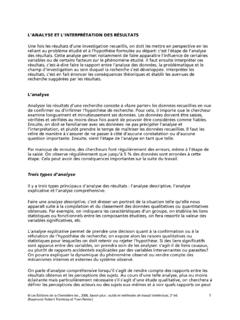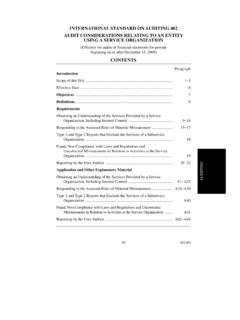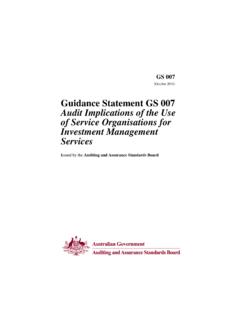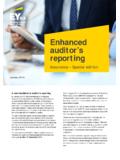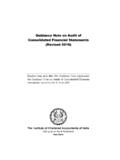Transcription of AUDITING FAIR VALUE MEASUREMENTS AND DISCLOSURES
1 AUDITING fair VALUE . MEASUREMENTS AND DISCLOSURES : ALLOCATIONS OF THE PURCHASE PRICE UNDER FASB. STATEMENT OF FINANCIAL ACCOUNTING STANDARDS NO. 141, BUSINESS COMBINATIONS, AND TESTS OF IMPAIRMENT UNDER. FASB STATEMENTS NO. 142, GOODWILL AND OTHER. INTANGIBLE ASSETS, AND NO. 144, ACCOUNTING FOR THE. IMPAIRMENT OR DISPOSAL OF LONG-LIVED ASSETS. A TOOLKIT FOR AUDITORS. Excerpts from FASB Statements No. 141, Business Combinations, No. 142, Goodwill and Other Intangible Assets, No. 144, Accounting for the Impairment or Disposal of Long-Lived Assets, Concepts Statement No. 6, Elements of Financial Statements, and Emerging Issues Task Force Issue No. 95-3, Recognition of Liabilities in Connection with a Purchase Business Combination,". copyright by Financial Accounting Standards Board, 401 Merritt 7, Norwalk, CT 06857, are reproduced by permission. Complete copies of the documents can be obtained from the FASB. ( ). ii Notice to Readers This publication, AUDITING fair VALUE MEASUREMENTS and DISCLOSURES : Allocations of the Purchase Price Under FASB Statement of Financial Accounting Standards No.
2 141, Business Combinations, and Tests of Impairment Under FASB. Statements No. 142, Goodwill and Other Intangible Assets, and No. 144, Accounting for the Impairment or Disposal of Long-Lived Assets, presents recommendations on the application of generally accepted AUDITING standards to audits of financial statements that recognize fair VALUE MEASUREMENTS under the referenced accounting standards. The guidance on AUDITING fair VALUE MEASUREMENTS in those circumstances is illustrated in this publication principally through discussions of its application in a business combination, as many concepts and principles are revealed in this common business situation. In addition to illustrating the application of guidance on AUDITING fair VALUE in a business combination, the concepts and procedures described herein may be useful when AUDITING goodwill and other intangible assets accounted for under Financial Accounting Standards Board (FASB) Statement No.
3 142 and when AUDITING impairment or disposal of assets accounted for under FASB Statement No. 144. Therefore, the illustrative audit program in Appendix III and illustrative disclosure checklist in Appendix IV cover FASB Statements No. 142 and No. 144. in addition to FASB Statement No. 141. Additionally, Appendix V and Appendix VI provide an overview of FASB Statements No. 141 and No. 144 and discuss certain AUDITING considerations. The AUDITING guidance in this publication is an Other AUDITING Publication as such is defined in Statement on AUDITING Standards (SAS) No. 95, Generally Accepted AUDITING Standards (AICPA, Professional Standards, vol. 1, AU sec. 150). Other AUDITING Publications have no authoritative status; however, they may help the auditor understand and apply SASs. If an auditor applies the AUDITING guidance included in an Other AUDITING Publication, he or she should be satisfied that, in his or her judgment, it is both appropriate and relevant to the circumstances of his or her audit.
4 The AUDITING guidance in this publication has been reviewed by the AICPA Audit and Attest Standards staff and is presumed to be appropriate. This publication has not been approved, disapproved, or otherwise acted upon by any senior technical committee of the AICPA or the FASB and, as previously indicated, has no authoritative status. iii FASB Statement No. 141 AUDITING Guidance Task Force Lynford E. Graham, Chair James S. Rigby, Jr. Greg Bailes Francis E. Scheuerell, Jr. AICPA Staff Gretchen Fischbach Charles E. Landes Technical Manager Director Audit and Attest Standards Audit and Attest Standards We wish to acknowledge that this publication draws from the following AICPA. publications: Professional Issues Task Force, Practice Alert No. 2002 02, Use of Specialists AICPA Practice Aid Assets Acquired in a Business Combination to Be Used in Research and Development Activities: A Focus on Software, Electronic Devices, and Pharmaceutical Industries The Task Force gratefully acknowledges the contributions of James S.
5 Gerson and John P. Brolly. The Task Force also acknowledges the following individuals whose technical review and comments contributed to the development of this publication: Brad Mescher, Herb Schulken, R. Scott Blackley, Susan L. Menelaides, Carl L. Williams, III, Steven L. Schenbeck, William F. Messier, Jr., Marc Simon, Neil J. Beaton, James Feldman, David R. Noonan, and Fred Widmann. iv INTRODUCTION AND OVERVIEW .. 1. fair VALUE CONCEPT IN FASB STATEMENT NO. 2. RESPONSIBILITY FOR fair VALUE MEASUREMENTS AND 2. Management's Responsibility for Making the fair VALUE MEASUREMENTS and DISCLOSURES .. 2. Auditor's Responsibility for Evaluating Conformity of fair VALUE MEASUREMENTS and DISCLOSURES With 3. AUDIT PLANNING 3. Knowledge of the Business .. 3. Risk 5. Timing Considerations .. 7. Auditor Experience Considerations .. 8. Use of a Valuation Specialist .. 9. SUBSTANTIVE TESTING OF fair VALUE MEASUREMENTS AND 14. General .. 14. Testing Significant Assumptions, Valuation Model, and Underlying Data.
6 15. Developing Independent fair VALUE Estimates for Corroborative 18. Reviewing Subsequent Events and Transactions .. 18. Consistency .. 19. DISCLOSURES in the Financial Statements of the Combined Entity .. 19. Evaluating Results of Procedures 20. COMMUNICATIONS .. 21. Management Representations .. 21. Communication With Audit Committees .. 22. REPORTING 22. Reliance on the Work of the Specialist .. 23. Scope Limitations .. 23. GAAP Departures .. 25. OTHER CONSIDERATIONS .. 25. Auditor's Responsibility for Information in Documents Containing Audited Financial Statements .. 25. Interim Period Reporting .. 26. APPENDIX I: VALUATION APPROACHES TO ESTIMATING fair 28. APPENDIX II: ILLUSTRATIVE CHECKLIST FOR BUSINESS COMBINATIONS .. 38. APPENDIX III: ILLUSTRATIVE AUDIT PROCEDURES FOR AUDITING UNDER FASB. STATEMENT NO. 141, BUSINESS COMBINATIONS; FASB STATEMENT NO. 142, GOODWILL AND OTHER INTANGIBLE ASSETS; AND FASB STATEMENT NO. 144, ACCOUNTING FOR THE IMPAIRMENT OR DISPOSAL OF LONG-LIVED 60.
7 APPENDIX IV: DISCLOSURE CHECKLIST: FASB STATEMENT NO. 141, BUSINESS. COMBINATIONS; FASB STATEMENT NO. 142, GOODWILL AND OTHER INTANGIBLE. v ASSETS; AND FASB STATEMENT NO. 144, ACCOUNTING FOR THE IMPAIRMENT OR. DISPOSAL OF LONG-LIVED ASSETS .. 77. APPENDIX V: IMPAIRMENT OF LONG-LIVED ASSETS TO BE HELD AND USED .. 93. APPENDIX VI: IMPAIRMENT OF 99. APPENDIX VII: MANAGEMENT CONSIDERATIONS WHEN ENGAGING A VALUATION. SPECIALIST .. 103. vi INTRODUCTION AND OVERVIEW. 1. Financial Accounting Standards Board (FASB) Statement of Financial Accounting Standards No. 141, Business Combinations, addresses financial accounting and reporting for business combinations. All business combinations within the scope of the Statement are accounted for using the purchase method. FASB Statement No. 141 requires the acquiring entity to, among other things, determine the cost of the acquired entity (that is, the purchase price) and to assign that cost to the assets acquired and liabilities assumed on the basis of their fair 2.
8 When financial statements under audit recognize the effects of a business combination, the auditor should obtain sufficient competent audit evidence to provide reasonable assurance that the fair VALUE MEASUREMENTS relating to the assets acquired in the business combination and the related DISCLOSURES in the financial statements are in conformity with generally accepted accounting principles (GAAP). The AICPA's AUDITING Standards Board has approved for issuance Statement on AUDITING Standards (SAS) No. 101, AUDITING fair VALUE MEASUREMENTS and The guidance in the SAS is general in nature and not intended to address AUDITING considerations relating to specific types of assets, liabilities, components of equity, transactions, or industry-specific practices. This publication provides guidance on AUDITING fair VALUE MEASUREMENTS and DISCLOSURES when the financial statements report the effects of a business combination accounted for as required by FASB Statement No.
9 141. That AUDITING guidance is based on SAS No. 101. 3. Given the complexity associated with estimating the fair values of the assets and liabilities of the acquired entity, the acquiring entity often engages or employs a valuation specialist. Among other things, the specialist should be an individual with skills and experience in developing fair VALUE measurement estimates. This publication contains guidance to help auditors evaluate the qualifications of the valuation specialist who estimates the fair VALUE of assets acquired and liabilities assumed in a business combination. The publication also will help auditors apply the AUDITING guidance in SAS No. 73, Using the Work of a Specialist (AICPA, Professional Standards, vol. 1, AU sec. 336). 1. It is not the intent of this publication to provide a comprehensive discussion of, or implementation guidance relating to, the accounting requirements in Financial Accounting Standards Board (FASB) Statement of Financial Accounting Standards No.
10 141, Business Combinations. Readers should refer to FASB Statement for an understanding of all of the applicable requirements of that standard. 2. Statement on AUDITING Standards (SAS) No. 101, AUDITING fair VALUE MEASUREMENTS and DISCLOSURES , is effective for audits of financial statements for periods beginning on or after June 15, 2003. Earlier application is permitted. 1. fair VALUE CONCEPT IN FASB STATEMENT NO. 141. 4. FASB Statement No. 141, defines the fair VALUE of an asset (liability) as the amount at which an asset (or liability) could be bought (or incurred) or sold (or settled) in a current transaction between willing parties, that is, other than in a forced or liquidation sale. Although GAAP may not prescribe the method for measuring the fair VALUE of an item, it expresses a preference for the use of observable market prices to make that determination. In the absence of observable market prices, GAAP requires fair VALUE to be based on the best information available in the circumstances.
